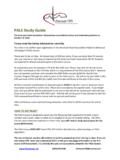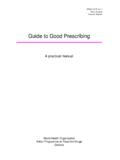Transcription of SELF-HELP STRATEGIES FOR CUTTING DOWN OR …
1 SELF-HELP STRATEGIES FOR CUTTING down OR STOPPING SUBSTANCE USE:A GUIDED raft Version for Field Testing Department of Mental Health and Substance Dependence World Health Organization Caveat relating to use of this Caveat relating to use of this Caveat relating to use of this Caveat relating to use of this documentdocumentdocumentdocument This document was written by Rachel Humeniuk, Sue Henry-Edwards and Robert Ali and is currently available for use in unpublished draft form only. Copies of this document are available on the WHO website for clinical and/or research purposes and should be referenced accordingly. Revisions and changes to this document may occur prior to formal publication. Formal publication of this document by the World Health Organization is anticipated to occur by 2005. Suggested reference: Rachel Humeniuk, Sue Henry-Edwards and Robert Ali.
2 SELF-HELP STRATEGIES for CUTTING down or Stopping Substance Use: A Guide. (Draft Version for Field Testing). Geneva, World Health Organization, 2003. This draft document is complemented by: This draft document is complemented by: This draft document is complemented by: This draft document is complemented by: Sue Henry-Edwards, Rachel Humeniuk, Robert Ali, Vladimir Poznyak and Maristela Monteiro. The Alcohol, Smoking and Substance Involvement Screening Test (ASSIST): Guidelines for Use in Primary Care (Draft Version for Field Testing). Geneva, World Health Organization, 2003. Sue Henry-Edwards, Rachel Humeniuk, Robert Ali, Maristela Monteiro and Vladimir Poznyak. Brief Intervention for Substance Use: A Manual for Use in Primary Care. (Draft Version for Field Testing). Geneva, World Health Organization, 2003. AcknowledgementsAcknowledgementsAcknowle dgementsAcknowledgements This draft is based on the data and experience obtained during the participation of the authors in the WHO Alcohol, Smoking and Substance Involvement Screening Test (WHO ASSIST) Project Phase III, coordinated and sponsored by the World Health Organization and implemented by the WHO ASSIST Phase III Working Group, that includes.
3 ROBERT ALI (AUSTRALIA) THOMAS BABOR (USA) MICHAEL FARRELL (UK) MARIA LUCIA FORMIGONI (BRAZIL) RACHEL HUMENIUK (AUSTRALIA) JAROON JITTIWUTIKARN (THAILAND) ROSELI BOERNGEN DE LACERDA (BRAZIL) WALTER LING (USA) JOHN MARSDEN (UK) JOSE MARTINEZ-RAGA (SPAIN) BONNIE MCREE (USA) MARISTELA MONTEIRO (WHO) DAVID NEWCOMBE (AUSTRALIA) HEMRAJ PAL (INDIA) VLADIMIR POZNYAK (WHO) SARA SIMON (USA) JANICE VENDETTI (USA) The preparation of this document was coordinated by Vladimir Poznyak and Maristela Monteiro from the WHO Department of Mental Health and Substance Dependence and Rachel Humeniuk and Robert Ali from Clinical Policy and Research Division, Drug and Alcohol Services Council, Parkside, WHO Collaborating Centre for Research in the Treatment of Drug and Alcohol Problems (Australia). Partial financial support for participation of the WHO Collaborating Centre for Research in the Treatment of Drug and Alcohol Problems in the WHO ASSIST Phase III Study was provided by the Australian Commonwealth Department of Health and Aging.
4 This guide is based on The Drinkers Guide to CUTTING down or CUTTING Out by David Ryder, Simon Lenton, Ilse Blignault, Carole Hopkins and Alex Cooke. Western Australian Alcohol and Drug Authority. Graphics and layout were provided by Momcilo Orlovic from the World Health Organization. Opportunity for feedbackOpportunity for feedbackOpportunity for feedbackOpportunity for feedback We invite your comments and feedback. We are particularly interested in your experiences in using this document and its usefulness and relevance in your clinical, or other, setting. If you have any feedback, comments, queries relating to this document please contact: Dr Rachel Humeniuk Senior Project Manager World Health Organisation Collaborating Centre for Research in the Treatment of Drug and Alcohol Problems Department of Clinical & Experimental Pharmacology University of Adelaide South Australia 5005 +61-8-8303 8056 (Phone) +61-8-8303 8059 (Fax) Dr Vladimir Poznyak Management of Substance Dependence (MSB), Department of Mental Health & Substance Dependence (MSD) World Health Organization 20 Avenue Appia 1211 Geneva 27, Switzerland +41-22-791 48 51 (Fax) World Health Organization World Health Organization World Health Organization World Health Organization This document is not a formal publication of the World Health Organization (WHO), and all rights are reserved by the Organization.
5 The document may, however, be freely reviewed, abstracted, reproduced, and translated, in part or in whole but it may not be sold or used in conjunction with commercial purposes. Inquiries should be addressed to the Department of Mental Health and Substance Dependence, World Health Organization, CH-1211 Geneva 27, Switzerland, which will be glad to provide latest information on any changes made to the text, regional adaptations and translations that are already available. The authors alone are responsible for the views expressed in this document, which are not necessarily those of the World Health Organization. THE SUBSTANCE USERS GUIDE TO CUTTING down OR STOPPING. DRAFT VERSION ONLY NOVEMBER 2003 3 TABLE OF CONTENTS 1. Introduction .. 4 2. How do you know if you are at risk .. 4 3. What is a substance use 5 4. Getting Started.
6 5 5. Getting Support .. 6 6. Do I need to do something about my substance 7 7. Which substances are you concerned 12 8. Measuring your substance 13 9. How much is too much .. 16 10. Choosing your goal .. 18 11. Changing the way you use .. 21 12. My contract with myself .. 22 13. Getting on with it .. 23 14. Keeping your Substance Use Diary .. 24 15. High Risk Situations .. 25 16. Setting Substance Use Guidelines .. 27 17. Helpful tips .. 29 18. Handling High Risk 31 19. The problem solving 31 20. How to say NO .. 33 21. Sticking to your guidelines .. 33 22. These tips will help 34 23. When things go .. 35 24. Alternatives to Substance Use .. 35 25. Guidelines for Supporters .. 36 Appendix .. 37 THE SUBSTANCE USERS GUIDE TO CUTTING down OR STOPPING. DRAFT VERSION ONLY NOVEMBER 2003 41. INTRODUCTION If you think your substance use is putting you at risk of experiencing health, social, legal, psychological, work or family problems then this guide will help you to weigh up your substance use habits and give you some ideas about how to change them.
7 The guide is designed for people who are at moderate risk of substance related problems and who do not have severe substance related problems or dependence. If you experience severe withdrawal symptoms when you stop using you should seek medical help from your doctor, health care worker or someone from a specialist drug and alcohol service. 2. HOW DO YOU KNOW IF YOU ARE AT RISK Different substances have different harms and risks, for example you are at risk of experiencing problems: If you regularly use tobacco products especially by smoking. If you regularly exceed guidelines for low risk drinking of alcoholic beverages. If you use substances such as cannabis, cocaine, amphetamine-type stimulants (including ecstasy and designer drugs ), inhalants, non prescribed sedatives or sleeping pills, hallucinogens, or opioids. If you have a copy of this document it may be because your doctor or health care worker has asked you some questions about your substance use and thinks you might be at risk of harm from one or more substances.
8 THE SUBSTANCE USERS GUIDE TO CUTTING down OR STOPPING. DRAFT VERSION ONLY NOVEMBER 2003 53. WHAT IS A SUBSTANCE USE PROBLEM Substance use problems can arise as a result of acute intoxication, regular use or dependence and from the way in which substances are used. It is possible for a person to have problems from all of these. Your doctor or health care worker may have given you a feedback card and information leaflets which contain information about specific health problems related to the substance(s) you use. Substance related problems can result from the way in which substances are used, for example, many of the harms associated with tobacco and cannabis occur because these substances are smoked and the smoke is harmful. Using substances by injection can cause serious health problems no matter which substance is injected. Injecting of any drug is a significant risk factor for contracting blood borne diseases such as HIV and Hepatitis B and C.
9 If you inject you are also at risk of infection and damage to the skin and veins as a result of poor injection technique, repeated injections, and dirty equipment. People who inject drugs have a higher risk of dependence and are likely to have more severe dependence than those who do not inject. Injecting of stimulant drugs such as amphetamines and cocaine increases the risk of drug related psychosis while injecting depressant drugs like heroin increases the risk of overdose. 4. GETTING STARTED You might already have decided that your substance use is causing problems for you. Or, you could want to check whether you really are using too much. Either way the rest of this booklet will help you look at where you are now, and how you could make changes. Changing our habits, substance use or otherwise, can seem scary or difficult. CHANGE IS POSSIBLECHANGE IS POSSIBLECHANGE IS POSSIBLECHANGE IS POSSIBLE THE SUBSTANCE USERS GUIDE TO CUTTING down OR STOPPING.
10 DRAFT VERSION ONLY NOVEMBER 2003 6As the old saying goes. A thousand mile journey starts with a single step . It doesn t really matter if you take breaks along the way: you ll still get there. What counts is deciding you want to make changes, and then making them, ONE SMALL STEP AT A ONE SMALL STEP AT A ONE SMALL STEP AT A ONE SMALL STEP AT A TIMETIMETIMETIME 5. GETTING SUPPORT You can use this guide by yourself without involving anyone else in what you are doing. However, it can be an enormous help to have your own supporter someone who understands what you want to do and is willing to spend time helping. A supporter needs to be some-one you trust and feel comfortable with, such as your partner, a friend, a relative, someone at work, a nurse, a priest or monk, a counsellor or a doctor. It is important that your supporter does not have a problem with substance use at the same time as trying to help you with your substance use.














